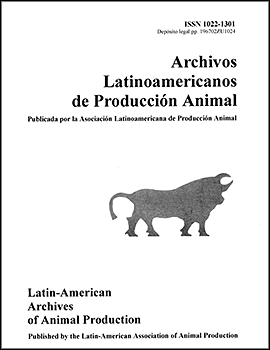
|
Archivos Latinoamericanos de Produccion Animal
Asociacion Latinoamericana de Produccion Animal
ISSN: 1022-1301
EISSN: 1022-1301
Vol. 16, No. 3, 2008, pp. 130-142
|
 Bioline Code: la08019
Bioline Code: la08019
Full paper language: English
Document type: Research Article
Document available free of charge
|
|
|
Archivos Latinoamericanos de Produccion Animal, Vol. 16, No. 3, 2008, pp. 130-142
| en |
Quantificação do carbono em sistemas de uso-da-terra no Distrito de José Crespo E Castillo, Peru
Alvarado, J. Rios; da Veiga, J. Bastos & de Santana, A. Cordeiro
Abstract
The objective of this study was esteemate the amount of carbon kidnapped in land use systems and (LUS) to compare with the culture of the cocaine Erythroxylon coca Lam. Ten land use systems had been evaluated: cocaine, secondary forest, and eigh is agroforestry system (AFS): AFS citric Citrus sinensis L of 30 and 15 years, AFS cocoa Theobroma cacao L traditional and improved, AFS pupunha Bactris gasipaes Kunth, AFS coffee Coffea arabica L, SPS Echinochloa polystachya HBK and Paspalum conjugatum Berg, The methodology was the indicated for carbono. The LUS the carbon kidnap vary for floristica biodiversity and stree and the systems that can be alternative to the culture of the cocaine, are the AFS with age between one and five years (coffee, pupunha, and SPS Echinochloa polystachya HBK), e with low amount the kidnapping of 12 the 35 years. The metodology was for determinity carbon. The UTS show to a great florística diversity the difference of the cocaine, that allows to store different amounts of carbon, being on these factors to the age of the systems, being those with tie five years (AFS coffee, AFS pupunha, SPS improved) the ones that had presented greater accumulate that those of bigger age. The total carbon storage and very similar aerial biomass es in the agroflorestais systems but vary in how much to carbon in the ground with the cocaine.
Keywords
Carbon Supply, Agroforestry system, coca (Erythroxylon coca Lam)
|
| |
| es |
Alvarado, J. Rios; da Veiga, J. Bastos & de Santana, A. Cordeiro
Resumen
O estudo teve como objetivo estimar o estoque de carbono em sistemas de uso-da-terra (SUT) e comparar com o do cultivo da coca Erythroxylon coca Lam. Avaliaram-se 10 sistemas de uso-da-terra: coca, capoeira, e oito sistemas agroflorestais (SAF), SAF cítrico Citrus sinensis L de 15 e 30 anos; SAF cacau Theobroma cacao L. tradicional e melhorado; SAF pupunha Bactris gasipaes Kunth; SAF café Coffea arabica L.; SSP Echinochloa polystachya HBK. e Paspalum conjugatum Berg. A metodologia usada foi a indicada para determinar carbono. Os SUT mostram uma grande diversidade florística a diferença da coca, que permite armazenar diferentes quantidades de carbono, estando ligado esses fatores à idade dos sistemas, sendo aqueles com ate cinco anos (SAF café, SAF pupunha, SSP melhorado) as que apresentaram maior acumulo que aqueles de maior idade. O armazenamento de carbono total e biomassa aérea es muito semelhante nos sistemas agroflorestais mais variam em quanto ao carbono no solo com a coca.
Palabras-clave
Carbono, sistemas agroflorestais, coca, capoeira, diversidade, idade
|
| |
© Copyright 2008 Archivos Latinoamericanos de Produccion Animal.
Alternative site location: http://www.alpa.org.ve/ojs/index.php
|
|
